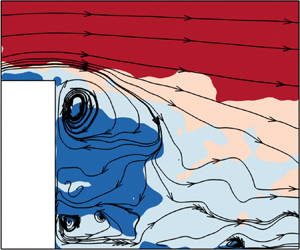Crossref Citations
This article has been cited by the following publications. This list is generated based on data provided by
Crossref.
Yan, Mengtao
Zhang, Zhiming
Gao, Shangce
and
Cao, Shuyang
2022.
Predicting aerodynamic pressure on a square cylinder from wake velocity field by masked gated recurrent unit model.
Physics of Fluids,
Vol. 34,
Issue. 11,
Crane, R.J.
Popinhak, A.R.
Martinuzzi, R.J.
and
Morton, C.
2022.
Tomographic PIV investigation of vortex shedding topology for a cantilevered circular cylinder.
Journal of Fluid Mechanics,
Vol. 931,
Issue. ,
Voskoboinick, Volodymyr
Onyshchenko, Arthur
Voskoboinyk, Oleksandr
Makarenkova, Anastasiia
and
Voskobiinyk, Andrij
2022.
Junction flow inside and around three-row cylindrical group on rigid flat surface.
Heliyon,
Vol. 8,
Issue. 12,
p.
e12595.
Fang, Xingjun
Tachie, Mark F.
and
Dow, Karen
2022.
Turbulent separations beneath semi-submerged bluff bodies with smooth and rough undersurfaces.
Journal of Fluid Mechanics,
Vol. 947,
Issue. ,
Devi, Kalpana
Hanmaiahgari, Prashanth Reddy
Balachandar, Ram
and
Vanteru, Mahendra Reddy
2022.
Reynolds number and submergence ratio effects on turbulence structures in the shallow wake of a horizontal pipe located on a rough bed.
Physics of Fluids,
Vol. 34,
Issue. 9,
Chen, Guang
Li, Xiao-Bai
Sun, Bo
and
Liang, Xi-Feng
2022.
Effect of incoming boundary layer thickness on the flow dynamics of a square finite wall-mounted cylinder.
Physics of Fluids,
Vol. 34,
Issue. 1,
Ho, Haonan H.
Essel, Ebenezer E.
and
Sullivan, Pierre E.
2022.
The interactions of a circular synthetic jet with a turbulent crossflow.
Physics of Fluids,
Vol. 34,
Issue. 7,
Das, S.
Abishek, S.
Balachandar, R.
and
Barron, R. M.
2023.
Wake characteristics of wall-mounted solid and foam-covered circular cylinders.
Physics of Fluids,
Vol. 35,
Issue. 11,
HE, Lin
LU, Xiaoge
HAN, Junhao
WU, Zhengbang
and
YI, Shihe
2023.
Time-resolved visualization of coherent structures during supersonic boundary layer transition.
Chinese Journal of Aeronautics,
Vol. 36,
Issue. 4,
p.
190.
Li, Jiawei
Rinoshika, Hiroka
Han, Xiaolei
Dong, Lin
Zheng, Yan
and
Rinoshika, Akira
2023.
Evolution and control of multiscale vortical structures in a wall-mounted cube wake.
Physics of Fluids,
Vol. 35,
Issue. 1,
Kang, Jinhao
and
Tachie, Mark F.
2023.
Experimental Study of Turbulent Wake Flow Around Trapezoidal Cylinders With Varying Streamwise Aspect Ratios.
Journal of Fluids Engineering,
Vol. 145,
Issue. 8,
Essel, Ebenezer E.
Balachandar, Ram
and
Tachie, Mark F.
2023.
Effects of sheltering on the unsteady wake dynamics of tandem cylinders mounted in a turbulent boundary layer.
Journal of Fluid Mechanics,
Vol. 954,
Issue. ,
Hajimirzaie, Seyed M.
2023.
Experimental Observations on Flow Characteristics around a Low-Aspect-Ratio Wall-Mounted Circular and Square Cylinder.
Fluids,
Vol. 8,
Issue. 1,
p.
32.
Liu, Yulu
Qi, Luomiao
Zhou, Jiankang
Li, Jiahua
Tao, Yizhou
and
Qiu, Xiang
2023.
Experimental research on wake characteristics and vortex evolution of side-by-side circular cylinders placed near a wall.
Ocean Engineering,
Vol. 285,
Issue. ,
p.
115268.
Sagharichi, Amir
Aleyasin, Seyed Sobhan
and
Tachie, Mark Francis
2023.
Turbulent separations around a slanted-back Ahmed body with square and rounded leading edge.
Physics of Fluids,
Vol. 35,
Issue. 4,
Chen, Guang
Li, Xiaobai
Xue, Rudai
He, Kan
Wang, Hanfeng
and
Liang, Xifeng
2023.
Effects of incoming free-stream turbulence on the flow dynamics of a square finite wall-mounted cylinder.
Physics of Fluids,
Vol. 35,
Issue. 2,
Ouedraogo, Newton F.
and
Essel, Ebenezer E.
2023.
Unsteady wake interference of unequal-height tandem cylinders mounted in a turbulent boundary layer.
Journal of Fluid Mechanics,
Vol. 977,
Issue. ,
Kumahor, Sedem
and
Tachie, Mark F.
2023.
Turbulent flow around a short rectangular cylinder in uniform flow at moderate Reynolds numbers.
Experimental Thermal and Fluid Science,
Vol. 147,
Issue. ,
p.
110960.
Zhou, Jiankang
Qiu, Xiang
Li, Jiahua
Wang, Bofu
Zhou, Quan
and
Liu, Yulu
2024.
The experimental investigation on wake dynamics of flow around a circular cylinder with the splitter plate.
Journal of Fluids and Structures,
Vol. 127,
Issue. ,
p.
104130.
Sagharichi, Amir
and
Tachie, Mark Francis
2024.
PIV analysis of wake characteristics of slanted-back Ahmed bodies: effect of leading-edge shape.
Experiments in Fluids,
Vol. 65,
Issue. 6,
